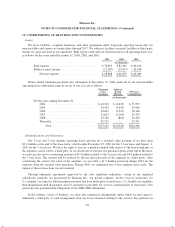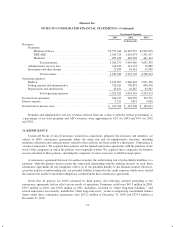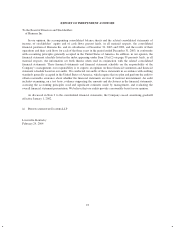Humana 2003 Annual Report Download - page 97
Download and view the complete annual report
Please find page 97 of the 2003 Humana annual report below. You can navigate through the pages in the report by either clicking on the pages listed below, or by using the keyword search tool below to find specific information within the annual report.
Humana Inc.
NOTES TO CONSOLIDATED FINANCIAL STATEMENTS—(Continued)
In addition, our business practices are subject to review by various state insurance and health care regulatory
authorities and federal regulatory authorities. There has been increased scrutiny by these regulators of the
managed health care companies’ business practices, including claims payment practices and utilization
management practices. We have been and continue to be subject to such reviews. Some of these have resulted in
fines and could require changes in some of our practices and could also result in additional fines or other
sanctions.
We also are involved in other lawsuits that arise in the ordinary course of our business operations, including
claims of medical malpractice, bad faith, nonacceptance or termination of providers, failure to disclose network
discounts, and various other provider arrangements, as well as challenges to subrogation practices. We also are
subject to claims relating to performance of contractual obligations to providers, members, and others, including
failure to properly pay claims and challenges to the use of certain software products in processing claims.
Pending state and federal legislative activity may increase our exposure for any of these types of claims.
In addition, several courts, including several federal appellate courts, recently have issued decisions which
have the effect of eroding the scope of ERISA preemption for employer-sponsored health plans, thereby
exposing us to greater liability for medical negligence claims. This includes decisions which hold that plans may
be liable for medical negligence claims in some situations based solely on medical necessity decisions made in
the course of adjudicating claims. In addition, some courts have issued rulings which make it easier to hold plans
liable for medical negligence on the part of network providers on the theory that providers are agents of the plans
and that the plans are therefore vicariously liable for the injuries to members by providers.
Personal injury claims and claims for extracontractual damages arising from medical benefit denials are
covered by insurance from our wholly owned captive insurance subsidiary and excess carriers, except to the
extent that claimants seek punitive damages, which may not be covered by insurance in certain states in which
insurance coverage for punitive damages is not permitted. In addition, insurance coverage for all or certain forms
of liability has become increasingly costly and may become unavailable or prohibitively expensive in the future.
On January 1, 2002 and again on January 1, 2003, we reduced the amount of coverage purchased from third party
insurance carriers and increased the amount of risk we retain due to substantially higher insurance rates.
We do not believe that any pending or threatened legal actions against us or any pending or threatened audits
or investigations by state or federal regulatory agencies will have a material adverse effect on our financial
position, results of operations, or cash flows. However, the likelihood or outcome of current or future suits, like
the purported class action lawsuits described above, or governmental investigations, cannot be accurately
predicted with certainty. In addition, the potential for increased liability for medical negligence arising from
claims adjudication, along with the increased litigation that has accompanied the negative publicity and public
perception of our industry, adds to this uncertainty. Therefore, such legal actions and government audits and
investigations could have a material adverse effect on our financial position, results of operations, and cash flows.
14. ACQUISITION
On May 31, 2001, we acquired the outstanding shares of common stock of a newly-formed Anthem Health
Insurance Company subsidiary responsible for administering TRICARE benefits in Regions 2 and 5 for
$43.5 million in cash, net of direct transaction costs. We accounted for this acquisition under the purchase
method of accounting and accordingly, our consolidated results of operations include the results of the acquired
business from the date of acquisition. We allocated the purchase price to net tangible and other intangible assets
based upon fair value. Any remaining value not assigned to net tangible or other intangible assets was then
allocated to goodwill. Other intangible assets of $11.8 million relate to the acquired government contract and
were amortized over the contract’s life assuming no extension, or approximately 2 years. Goodwill recorded in
89
























